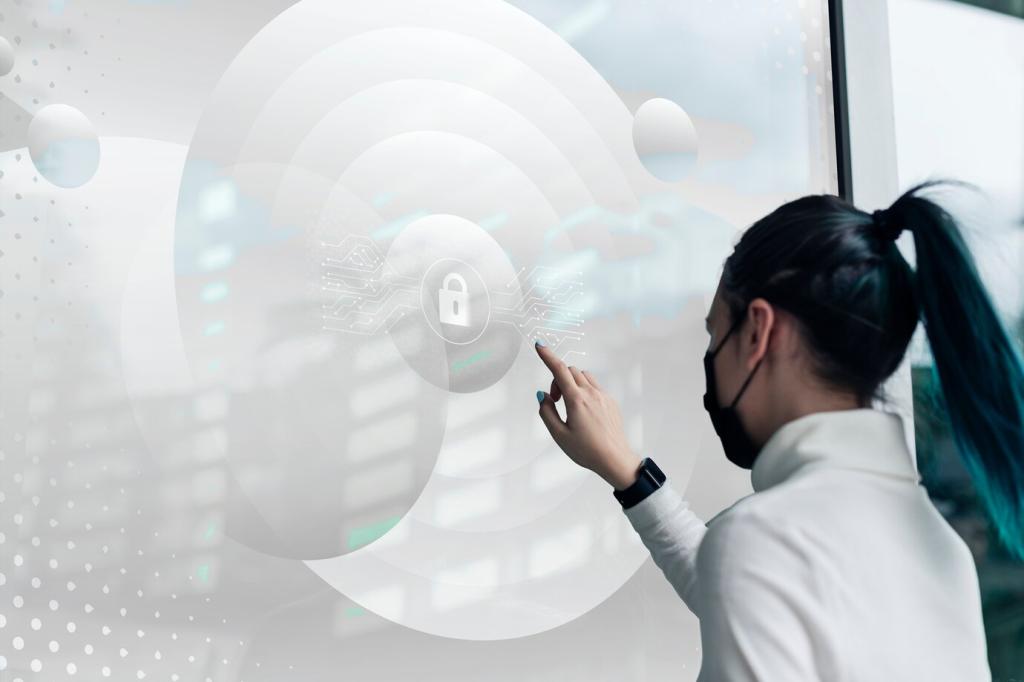In today’s fast-paced digital landscape, small businesses face increasing cyber threats that can compromise sensitive data, disrupt operations, and harm reputations. While resources may be limited, implementing advanced cybersecurity measures is essential to protect your business, customers, and employees. This page explores robust strategies tailored for small businesses to defend against evolving cyberattacks, ensuring resilience and trust in a tech-driven marketplace.
Multifactor Authentication Implementation
Multifactor authentication (MFA) requires users to verify their identity using two or more methods, such as passwords, biometrics, or one-time codes. Implementing MFA significantly increases security because even if a password is compromised, unauthorized users cannot gain access without the additional authentication factors. For small businesses, adopting MFA solutions is now more accessible than ever, often available through cloud services and affordable security tools. Encouraging employees to use MFA for all critical accounts—email, HR systems, and payment platforms—dramatically reduces the risk of unauthorized access and helps meet compliance standards.
Strong Password Policies
Creating strong password policies is fundamental to safeguarding business accounts. Policies should require complex combinations of letters, numbers, and special characters, alongside regular updates. Small businesses can benefit from deploying password managers to help employees generate and store robust passwords securely, minimizing the risk of weak or reused passwords. Mandating that passwords are never shared or written down in unsecured locations further limits potential breaches. By fostering a culture of password security, small businesses bolster their defense against brute-force and phishing attacks that capitalize on predictable credentials.
Single Sign-On and Identity Management
Single sign-on (SSO) streamlines the user authentication process by allowing employees to access multiple applications with one set of credentials. By integrating SSO with identity management tools, small businesses gain visibility into user activity and can swiftly disable accounts in case of employee turnover or detected threats. These technologies reduce password fatigue, improve user experience, and limit attack vectors, especially as cloud adoption rises. Enforcing centralized authentication systems ensures that access rights are tightly controlled and auditable, thus enhancing overall security posture.
Securing Network Infrastructure
Firewalls serve as a critical defense between your business data and external threats. Properly configured firewalls inspect incoming and outgoing data packets to prevent malicious content from entering or leaving your network. For small businesses, investing in next-generation firewalls with advanced features such as intrusion detection and malware protection is increasingly affordable. Periodic firewall audits and updates help maintain optimal security, adapting to emerging threats and new devices on your network.
Data Encryption and Backup Protocols
End-to-End Data Encryption
End-to-end encryption ensures that only authorized users can read sensitive data, both while it is stored (at rest) and when it is being transmitted (in transit). Small businesses need to encrypt customer records, financial data, and any proprietary information, using strong algorithms like AES-256 and ensuring encryption keys are managed securely. As regulatory requirements for data privacy grow, implementing thorough encryption protocols gives small businesses an edge in achieving compliance while deterring data thieves.

Automated, Regular Data Backups
Routine, automated backups protect small businesses from data loss caused by cyberattacks, accidental deletion, or hardware failures. By employing backup solutions that store copies both onsite and offsite—ideally in secure, cloud-based environments—businesses can recover quickly with minimal disruption. It is essential to test backup systems regularly for integrity and accessibility, ensuring that the process is reliable and data can be restored in case of an emergency.
Employee Awareness and Training Programs
Phishing emails remain a primary entry point for cybercriminals targeting small businesses. Implementing regular, tailored training that educates staff on identifying fraudulent emails, malicious attachments, and social engineering techniques builds confidence and competence. Realistic phishing simulations help employees practice decision-making in safe environments, revealing common mistakes and improving overall preparedness against deception attempts.

Antivirus and Anti-Malware Solutions
Deploying reputable antivirus and anti-malware software across all endpoints—desktops, laptops, and mobile devices—prevents infections and automatically removes malicious software. These solutions offer real-time scanning and alert users to suspicious behavior, keeping small businesses one step ahead of evolving cybercriminal tactics. Regular updates are critical to ensure these protections defend against the latest threats, making automated patch management an important aspect of device security.
Device Encryption and Mobile Security
Encrypting files and drives on employee devices provides an additional safeguard in case of physical loss or theft. Small businesses should also establish mobile device management (MDM) policies that enforce security settings, application controls, and remote wipe capabilities. These measures secure both company-issued and personal devices used for work, ensuring sensitive data is inaccessible to unauthorized individuals, even if a device leaves your control.
Remote Access Security Controls
With the rise of remote and hybrid workforces, managing and monitoring remote access is more important than ever. Implementing secure connections through VPNs, restricting administrative privileges, and enforcing device compliance checks mitigates risk. Remote desktop protocols should be configured securely, with strong authentication and continuous monitoring for unusual activity. These steps collectively reduce vulnerabilities introduced by offsite work.
Ongoing Threat Detection and Monitoring
01
Security Information and Event Management (SIEM) platforms collect and analyze logs from various systems, correlating data to detect suspicious activities or policy violations. For small businesses, cloud-based SIEM solutions offer affordable real-time monitoring and alerting capabilities. By centralizing threat intelligence, SIEM empowers organizations to identify attacks early and comply with regulatory requirements concerning event logging and incident response.
02
Intrusion detection and prevention systems monitor network and endpoint activity for signs of attack, automatically blocking or alerting against suspicious behavior. Small businesses can deploy host-based or network-based IDPS solutions that integrate with existing infrastructure, providing an extra layer of defense. These tools use updated threat signatures and behavioral monitoring to catch both known and emerging threats, often stopping attacks before they progress.
03
Artificial Intelligence (AI) is revolutionizing threat detection by learning normal user and network behavior, flagging deviations that may indicate a cyberattack. Small businesses leveraging AI-powered tools can identify nuanced threats—such as insider sabotage or sophisticated phishing—that traditional defenses might miss. Implementing anomaly detection reduces response times and builds resilience against evolving, highly targeted attacks.

Creating a Response Playbook
An incident response playbook contains detailed, step-by-step guidance for managing different types of security incidents, from ransomware attacks to data breaches. For small businesses, having accessible, role-based instructions increases the likelihood of coordinated and effective responses. Developing and frequently updating your playbook ensures alignment with new threats, technologies, and organizational changes, making the response process smoother and less overwhelming.
Business Continuity and Disaster Recovery
Business continuity plans and disaster recovery strategies are essential for maintaining operations following a cyber incident. These plans outline processes for restoring systems, communicating with stakeholders, and resuming key business activities. Small businesses should identify critical functions and prioritize their recovery, ensuring minimal disruption to customers and partners. Regular drills and reviews of these plans help teams act confidently under real-life pressure.
Post-Incident Analysis and Improvements
After containing and recovering from an incident, thorough post-incident analysis uncovers root causes, highlights gaps, and recommends improvements. Small businesses benefit from conducting debriefs with all involved personnel, documenting lessons learned and updating policies as necessary. This continuous improvement cycle strengthens defenses, reduces future risks, and demonstrates to stakeholders that security remains a top organizational priority.
Ensuring Regulatory Compliance
Understanding Industry Regulations
Small businesses must identify industry-specific regulations, such as GDPR, HIPAA, or PCI DSS, that govern data handling and cybersecurity practices. A clear understanding of these frameworks helps prioritize security initiatives and avoid costly fines or legal action. Consulting with legal and compliance experts ensures your business remains aligned with regulatory demands as they evolve.
Privacy Policy Development and Transparency
Developing clear, accessible privacy policies demonstrates to customers your commitment to safeguarding their personal data. These policies should articulate how data is collected, used, stored, and shared within your business operations. Transparency in privacy practices is increasingly scrutinized by regulators and customers alike, making it essential for small businesses to keep documentation current and prominently available.
Routine Compliance Auditing
Conducting regular audits verifies that cybersecurity measures meet regulatory standards and internal policies. Audits assess controls, document vulnerabilities, and identify areas for improvement in a systematic, repeatable manner. Small businesses can utilize third-party services or in-house checklists to conduct these reviews, providing confidence to clients and partners that your operations uphold the highest standards of data protection.

